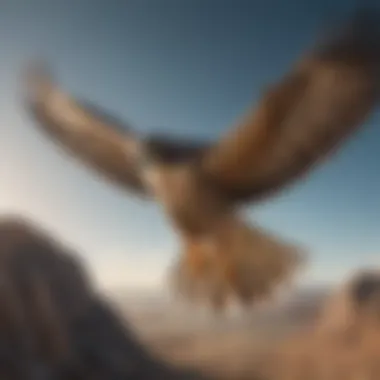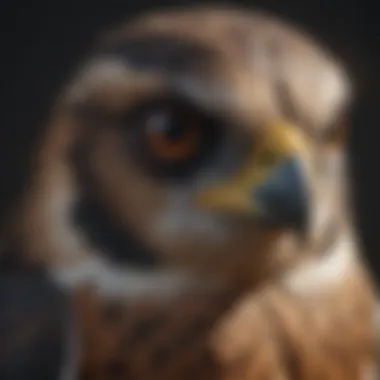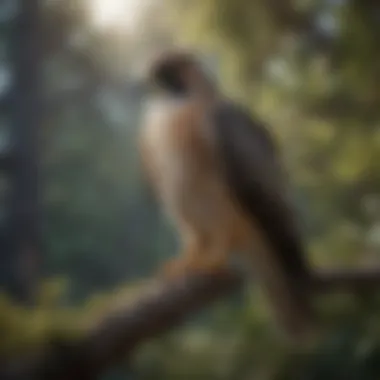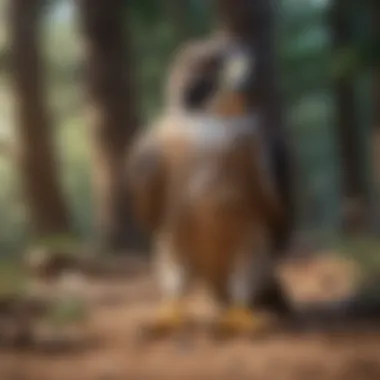Discovering the Amazing World of Falcons


Nature Topic Overview
Falcons are truly unique birds of prey, known for their speed and agility. These remarkable creatures belong to the family Falconidae, comprising over 60 species. This article dives into the fascinating characteristics, behaviors, habitats, and conservation efforts surrounding falcons. For children aged 5 to 12, an engaging exploration of these birds offers knowledge and a deeper appreciation for wildlife and nature. Let us begin our adventure into the world of falcons.
Fun Facts and Trivia
Falcons capture the imagination of many. Here are some fun facts that young learners will find exciting:
- Fastest Animal on Earth: The Peregrine Falcon is famous for its speed, capable of reaching over 240 miles per hour during a dive.
- Excellent Vision: Falcons can see four to eight times better than humans, enabling them to spot prey from great distances.
- Diverse Colors: Many falcon species have distinct color patterns. The Merlin Falcon, for example, is a mix of grey and brown.
Visuals such as images or simple diagrams showing the different types of falcons can enhance understanding. This makes learning both fun and interactive.
Wildlife Explorations
There are various species of falcons that inhabit different regions. Some common species include:
- Peregrine Falcon: Known for its impressive dive speed and adaptability in urban environments.
- American Kestrel: The smallest falcon in North America, easily recognized by its colorful plumage.
Exploring hawks, eagles, and other raptors helps to highlight the unique ecosystem these birds occupy. These animals all play crucial roles in their habitats, whether by controlling rodent populations or contributing to biodiversity. Additionally, pathways for quizzes about identifying different falcon types can add an interactive touch for young readers.
Environmental Awareness
Conservation of falcons and their habitat is critical. Here are reasons why it matters:
- Role in the Ecosystem: Falcons balance prey populations, ensuring ecosystems remain healthy.
- Threats to Survival: Habitat destruction and pollution significantly threaten many falcon species.
Tips for children on helping protect nature include:
- Participate in local clean-up events.
- Build birdhouses to support nesting.
- Educate friends and family about wildlife and conservation.
“Educating young minds fosters a love for wildlife and commitment to conservation.”
DIY Nature Activities
Children can engage with nature through DIY activities that inspire curiosity and creativity:
- Create Bird Feeders: Use recycled materials, like milk cartons, to make bird feeders, attracting various birds to observe.
- Sketch Falcon Patterns: Encourage children to draw or color different falcon species, learning about their colors and characteristics in the process.
- Outdoor Scavenger Hunt: Organize scavenger hunts where kids search for feathers, nests, or signs of wildlife to promote observation skills and interaction with nature.
These activities not only reinforce learning but also nurture a lifelong appreciation for our earthly companions. The beauty and complexity of falcons should inspire deeper respect for nature.
This exploration into falcons cannot only educate but can ignite a passion for wildlife preservation. The remarkable world of falcons awaits enthusiastic young learners eager to discover the beauty of nature.
Foreword to Falcons
Falcons are remarkable birds known for their agility, sharp eyesight, and impressive hunting skills. This introductory section sets the foundation for understanding these fascinating creatures. In this article, we will delve into their characteristics, behaviors, and habitats, enlightening readers on the significance of falcons in our environment and culture.
What Are Falcons?
Falcons belong to the family Falconidae. This group comprises various species found across the globe. They exhibit unique features such as long, pointed wings and a distinctive notch in their beaks. These adaptations help them hunt effectively and navigate through their habitats with grace.
Unlike other birds of prey, falcons are incredibly known for their speed. They can dive at astonishing speeds, making them some of the fastest animals on the planet. Typically, they weigh between 0.5 kg to 2 kg, depending on the species. The Peregrine Falcon is among the most notable, capable of reaching speeds beyond 240 kilometers per hour during its hunting stoop (high-speed dive).
The Importance of Falcons in Nature
Falcons play a crucial role in the ecosystems they inhabit. As predatory birds, they help maintain the balance in nature by controlling the populations of smaller birds and rodents. This control prevents overpopulation and promotes biodiversity within their environments.
Moreover, falcons serve as indicators of environmental health.
When falcon populations decline, it often signals larger ecological issues that need to be addressed. Their presence suggests a balanced ecosystem is on the right track.


Additionally, falcons contribute to cultural and educational aspects within human societies. They have been subjects of art, literature, and even mind fascinating falconry traditions throughout centuries. Educating the audience about these aspects fosters a deeper appreciation for these birds and nature as a whole.
Falcon Species
Falcon species are central to understanding the diversity and adaptability of these birds. The different species highlight various traits and behaviors that emphasize the capabilities of falcons, whether in hunting techniques or their physical attributes. Furthermore, learning about specific falcon species can foster an appreciation for their role in nature and the ecosystems they inhabit.
Common Falcon Species
Peregrine Falcon
The Peregrine Falcon is known for its incredible speed, reaching over 240 miles per hour during its characteristic hunting stoop. This unparalleled speed allows it to catch other birds mid-flight, showcasing its efficiency as a predator. The key characteristic of the Peregrine is its adaptability to varied environments, making it a global representative of the falcon family. The strenuous environmental conditions it faces in urban areas also illustrate its remarkable capacity to survive in non-native habitats.
The unique feature of the Peregrine Falcon is its countershading; the dark upper parts and lighter underparts assist in ambushing prey from heights. This advantage is particularly beneficial for those learning about falcons, as it illustrates a critical venture in evolution – the adaptation of predatory skills.
American Kestrel
The American Kestrel captivates many with its striking plumage and being the smallest falcon in North America. This minimizes its need for vast territories compared to larger species, favoring a broader inhabitance across various landscapes. The key characteristic here involves its adaptability, often seen perched on roadside wires, showcasing uncommon behaviors and resilience.
One unique feature of the American Kestrel is its varied diet, which allows it to clear catch insects, small mammals, and birds. This trait not only enhances biodiversity in its region, but it serves as an excellent demonstration to children learning about the energy levels across food webs.
Gyrfalcon
The Gyrfalcon, the largest of the falcon species, commands attention with its majestic presence and strength. Its impressive hunting technique in cold climates makes it a symbol of resilience. The key characteristic lies primarily in its larger size, equipped for intense hunting of large birds and mammals.
A notable unique feature of the Gyrfalcon is its color variations, which range from dark gray to pure white. This variability aids its species in camouflage against different snowy backgrounds and hunting under diverse conditions. Appreciating the Gyrfalcon enhances knowledge about adaptation and convenience in survival, invaluable for our audience targeting young learners.
Rare and Unique Falcons
Sooty Falcon
Easily overlooked, the Sooty Falcon occupies a somewhat niche position among falcons. Its migratory habits and unique dietary preferences provide rich avenues for discovery. The key characteristic of this falcon is its dependency on specific habitats that influence its breeding and feeding behaviors.
What makes the Sooty Falcon unique is its preference for warm coastal regions and a varied diet, heavily relying on migrating passerines. Understanding its habits provides essential insights into ecological balances and the complexities of habitat conservation, particularly relevant for young environmentally conscious minds.
Eleonora's Falcon
Eleonora's Falcon embodies uniqueness in its reproductive timing, nesting after the summer migration. This distinct pattern emphasizes its dependency on seasonal movements of prey. The key characteristic of this falcon is its adaptability to late breeding which allows it to synchronize parenting with the availability of their favored food in the region.
Physical Characteristics
Understanding the physical characteristics of falcons is vital. These features not only define their appearance but also contribute to their survival skills and hunting behavior. By focusing on elements like size, wingspan, and unique adaptations, one can appreciate how falcons thrive in diverse environments.
Size and Wingspan
Falcons exhibit varied sizes across different species. For instance, the Peregrine Falcon can measure between 14 to 19 inches long, while the larger Gyrfalcon can reach up to 25 inches. Wingspan also varies significantly, with some falcons having spans exceeding 4 feet. The wings are built for high-speed pursuits, allowing these birds to soar gracefully yet strike swiftly.
There is some evidence that suggests larger size can provide advantages, but also has drawbacks like requiring more energy. Smaller falcons like the American Kestrel are nimble and can maneuver swiftly among trees. Therefore, size plays a critical role in their hunting success and ability to escape from predators.
Color and Markings
Colors and markings are another fascinating aspect of falcon anatomy. Varieties can include striking patterns such as spots, stripes, and distinct colorations like reddish-brown or blue-gray. For example, the juvenile American Kestrel displays bright coloring while adult kestrels shift to duller shades, providing concealment. This coloring offers dual benefits: attracting mates and aiding in camouflage.
This adaptability in coloration helps falcons blend into different habitats. For individuals interested in identification, observing plumage can be an effective way to recognize various species in the wild.
Talons and Beak Adaptations
Falcons are equipped with strong talons and uniquely shaped beaks. Their talons are sharp and curved, designed for gripping prey effectively. Different species can have variations in size and shape of their talons, optimizing them for specific hunting techniques. For instance, the Peregrine's talons are robust and built to pierce through tough feathers and skin.
The beak of a falcon is also highly adapted. It features a hooked structure which allows the falcon to tear flesh efficiently. These adaptations are central to how these birds catch, kill and consume their prey. Overall, their physical traits contribute significantly to their prowess as skilled hunters in the diverse realms they inhabit.
Researchers believe the talons and beak of falcons have evolved over time to adapt to environmental pressures and prey availability, showcasing Nature's incredible ingenuity.


Diet and Hunting Behavior
Understanding the diet and hunting behavior of falcons is crucial to appreciating their role as predatory birds. Their eating habits and techniques define their lifestyle. Through these habits, we can see how falcons adapt to their environment for survival and their impact on maintaining balance in ecosystems.
What Do Falcons Eat?
Falcons have a diverse diet, mainly consisting of other birds. They are skilled hunters capable of taking down prey that is smaller or of comparable size. Their menu can include:
- Small Birds: Sparrows, finches, and pigeons are common targets.
- Insects: In the absence of birds, they may turn to hunt large insects.
- Rodents: Some species also catch rodents, particularly the nesting chicks.
- Aquatic Prey: Certain falcons hunt small fish when near water bodies.
The specific food choices can vary by species and habitat. Falcons are opportunistic, meaning they eat what is available and easiest to hunt in their surroundings. This flexibility contributes to their success.
Hunting Techniques
Falcons are known for their impressive hunting techniques, honed through evolution. Their methods are fascinating and exhibit remarkable skills. Here are some common hunting techniques:
- Stooping: This is a high-speed dive where the falcon spots its prey from a great height and dives swiftly to catch it by surprise.
- Perch and Pounce: Falcons often wait on high perches and observe their surroundings. When they see suitable prey, they take flight quickly.
- Chase: In some cases, falcons engage in a prolonged chase, using their speed to outpace and catch their target over various terrains.
Falcon's remarkable speed can reach over 240 miles per hour during a stoop, making it one of the fastest creatures on the planet.
Falcons rely on their excellent eyesight and sharp talons, which enable them to navigate and catch prey efficiently. Through their diverse feeding and hunting strategies, they play an essential part in regulating animal populations in their environments.
Habitat and Range
Understanding habitat and range is crucial when discussing falcons, as this informs how they survive and thrive in various environments. Falcons can be found on every continent except Antarctica, showcasing their adaptability to different climates, landscapes, and ecosystems. Their ability to occupy diverse habitats speaks to their evolution and resilience.
Their habitats can vary significantly, which impacts their hunting and breeding behaviors. From the deserts of the Southwestern United States to the forests of Europe, knowing where falcons reside can enhance our appreciation for their ecological roles. In this section, we delve into their specific locations and migratory behaviors, underlining the significance of these aspects in their life cycle.
Where Do Falcons Live?
Falcons typically prefer environments that provide suitable perches for hunting and that are rich in prey. This can include:
- Urban areas: Many falcons, such as the Peregrine Falcon, are known to adapt to city landscapes, nesting on skyscrapers or bridges.
- Open fields and grasslands: American Kestrels often hunt in these areas for small rodents and insects.
- Coastal regions: Falcons like the Eleonora's Falcon are found near coastlines, taking advantage of oceanic currents.
- Forested regions: Some species prefer woodlands where they can find cover and ample small bird populations.
Besides residing in wide-ranging habitats, falcons are also skilled at utilizing various nesting sites. They often prefer high cliffs or tall structures, allowing them an unobstructed view of their surroundings.
Migration Patterns
Falcons exhibit fascinating migratory behaviors, which reflect their adaptability and survival strategies. While some species are sedentary, others migrate long distances seasonally. A few key points about their migration are:
- Timing: Falcons often migrate during early hours of the morning or late afternoon to avoid predators.
- Routes: They tend to follow geographical landmarks, such as mountain ranges, coastlines, and river valleys, during migration.
- Seasonal changes: Migration is heavily influenced by changes in weather, temperature, and availability of prey.
For instance, the Peregrine Falcon flees harsher winter climates for warmer regions, illustrating the importance of climate in their migration patterns. Knowing these migration paths helps ornithologists monitor population changes and assess conservation efforts.
Breeding and Lifecycle
Understanding the breeding and lifecycle of falcons is crucial as it outlines how these magnificent birds reproduce and nurture their young. This knowledge reveals the complexities of their existence, and enhances our appreciation for wildlife. It also highlights the challenges falcons face during breeding every year.
Nesting Habits
Falcons typically choose high, inaccessible locations for nesting. This strategy minimizes the threat from predators. Natural nests can be found on cliffs, tall trees, and even tall buildings in urban developments.
Peregrine falcons, for example, commonly use ledges or nesting boxes installed on skyscrapers. They are known for returning to the same nest year after year, demonstrating strong site fidelity. Nesting involves the female laying eggs, usually between two to four. These eggs are incubated for about 28 to 32 days. During this time, the male is responsible for bringing food to the female.
Chick Development
Hatching
Hatching is a critical time in the lifecycle of a falcon. When the chicks are ready to emerge, they tap on the egg’s shell using a special beak called an egg tooth. This unique feature helps them break through the shell and is essential for their survival.


The common characteristic of hatching is the synchronization of hatching times among siblings, especially in species like the peregrine falcon. This ensures that siblings can support each other while they grow strong.Hatching is a significant event in their lifecycle because it marks the transition from egg to chick, leading to the continuation of the falcon population.
Fledging
Fledging occurs several weeks after hatching when the young falcons begin to leave the nest. One distinctive characteristic of fledging is the way the chicks learn to fly. Initially, they make short hops before attempting their first full flight. This stage is vital because it prepares them for independence and self-sustenance in the wild.
It is a beneficial part of their lifecycle; young falcons develop essential flying and hunting skills that enable their survival. While learning to fly presents certain risks, it is crucial for their development as it sets the foundation for their role in the ecosystem as efficient hunters.
As such, the breeding and lifecycle of falcons, including nesting habits, hatching, and fledging, are essential to understanding their behavior and conservation needs. Learning about these stages can inspire greater respect and awareness for these fascinating birds, enriching both educational pursuits and wildlife conservation efforts.
Conservation Status
Understanding the conservation status of falcons is vital. This section not only informs us about how these birds are doing in their natural environment but also highlights the various factors affecting their populations. With their unique roles in the ecosystem, falcons help maintain balance. When falcons are endangered or threatened, it can have a chain reaction, impacting other wildlife. Hence, knowledge of their conservation status brings awareness to initiatives preserving these important birds.
Threats to Falcon Populations
Falcons face several significant threats that have impacted their population negatively. Here are the main concerns:
- Habitat Loss: Urban expansion and agricultural development have led to habitat destruction. As places where falcons hunt or nest disappear, their populations can shrink.
- Pesticides and Pollution: These substances accumulate in the environment and can affect falcons' health over time. When birds consume contaminated prey, they can ingest toxins that harm them.
- Climate Change: Weather changes can alter hunting patterns and affect food supply. For instance, warm winters may not kill enough prey, leading to scarcity during breeding seasons.
- Illegal Trade and Hunting: Some species of falcons are captured and sold illegally or hunted, which contributes solely to their decline.
It is critical that we recognize and address these threats to support the survival of falcons.
Conservation Efforts
Counteracting the issues facing falcons requires concerted efforts from many groups. Various initiatives aim to protect their population:
- Protected Areas: Establishing nature reserves can safeguard habitats where falcons thrive. These areas limit human interference and enhance breeding chances.
- Public Education: Informing the public about the significance of falcons fosters appreciation. Educational programs in schools can spark interest in conservation.
- Regulation of Pesticides: Stricter regulations on pesticide use can help reduce contaminants in the food chain that affect falcons.
- Research Programs: Ongoing studies into falcon behavior and health help conservationists devise effective strategies for protection.
Falcons in Culture
Falcons have played a notable role throughout human history and continue to impact modern culture in various ways. Their impressive abilities and symbolic meanings give insights into how they relate to our lives. Understanding the cultural significance of these birds helps us appreciate their unique place in the world.
Falcons in History
Historically, falcons have fascinated people for centuries. They were used in falconry, a sport that involves training these birds to hunt game. This tradition started in Asia and spread to Europe. In medieval times, falconry was a pastime of the nobility, highlighting not only the beauty and grace of the falcon, but also the status of the owner. Each type of falcon brought different skills; for example, the Peregrine Falcon is valued for its incredible speed.
Falcons often represented nobility, power, and freedom. In ancient Egyptian culture, the god Horus, often depicted as a falcon, symbolized protection and kingship. This view has influenced art and literature, embedding falcons within our history.
Falcons in Modern Media
Today, falcons continue to captivate audiences through various forms of media. They appear in movies, books, and even video games, sparking interest and curiosity about their lives. For instance, in the well-known movie The Falcon and the Snowman, a falcon symbolizes loyalty and freedom.
Additionally, several children's books feature falcons. These stories aim to entertain while providing factual information about their behavior and habitat. In video games, falcons may be playable characters, allowing users to experience hunting prey from a bird's perspective.
This representation in media reinforces the idea of falcons as not just simple animals, but as iconic creatures in both storytelling and our collective modern identity.
As you explore the depth of falcon culture, remember, these birds reflect not only nature’s wonders but also our shared human experiences.
Interesting Facts
In this section, we delve into intriguing facts surrounding falcons. Understanding these unique aspects adds depth to our knowledge about falcons and enhances our appreciation for them. Knowledge about falcons will stimulate curiosity, especially among younger audiences. Facts such as their exceptional speed and fascinating behaviors can ignite a passion for wildlife.
Falcons and Speed
Falcons are renowned for their unbelievable speed. The Peregrine Falcon holds the title for being the fastest bird, capable of reaching speeds up to 240 miles per hour during a dive. This impressive speed enables them to hunt effectively, allowing them to catch prey mid-air. Their aerodynamic body shape and powerful muscles contribute significantly to their velocity. Illustrating their swift movements captures the attention of young learners and inspires awe.
- Speed Record Holders: The Peregrine Falcon is the fastest, but several falcon species possess notable speed capabilities.
- Hunting Style: When they dive to catch prey, they use their speed to face challenges from hardy birds and avoid risks.
Jobbing away from trouble seems to favor falcons as their instincts and abilities aid their survival, making speed a vital feature.
Unique Falcon Behaviors
Falcons exhibit several unique behaviors that contribute to their survival and success as predators. One standout behavior is their impressive hunting technique known as the "stoop," where they dive at high speeds to surprise their prey. Additionally, falcons are very territorial birds. They rigorously defend their nesting sites from intruders, leading to fascinating territorial displays.
- Social Interaction: Many falcon species engage in intricate courtship behaviors, helping strengthen their bonds.
- Adaptation Habits: Falcons are not just passive creatures; they modify their hunting styles based on their environment and prey. They may chase or lay in wait according to circumstances.
Falcons adapt smartly, ensuring they thrive in various conditions. This adaptability exhibits nature's way of pushing toward survival.







